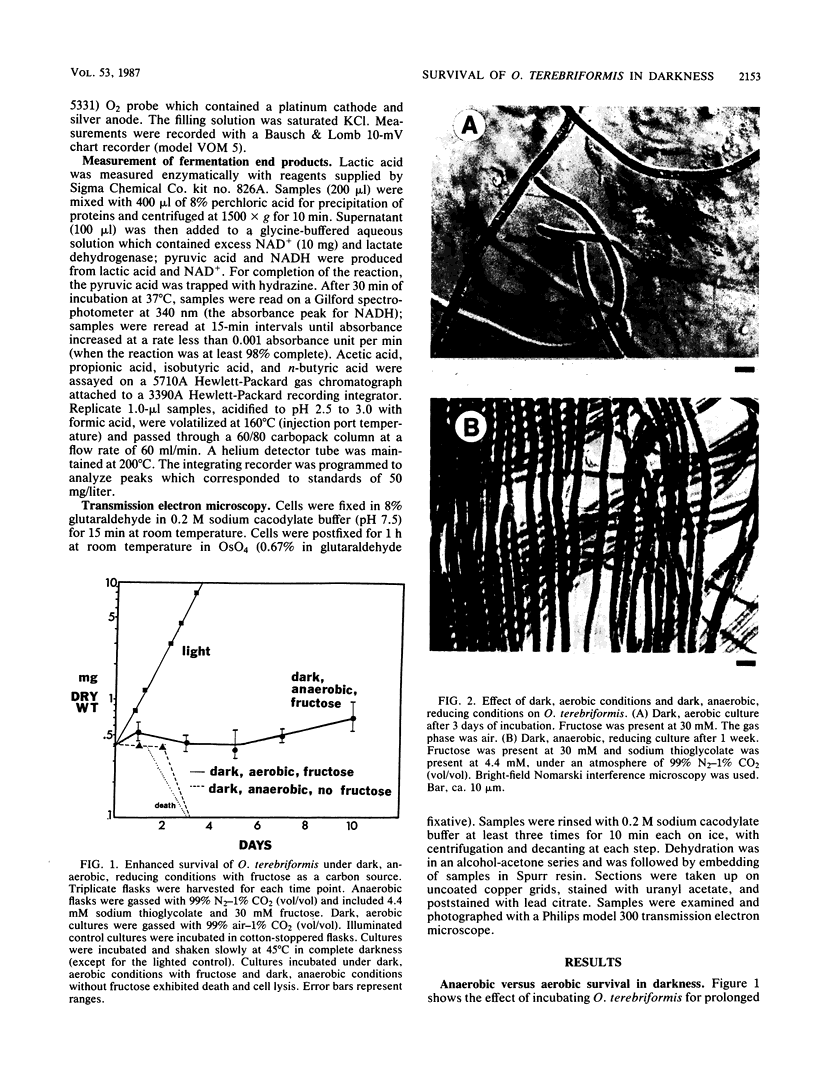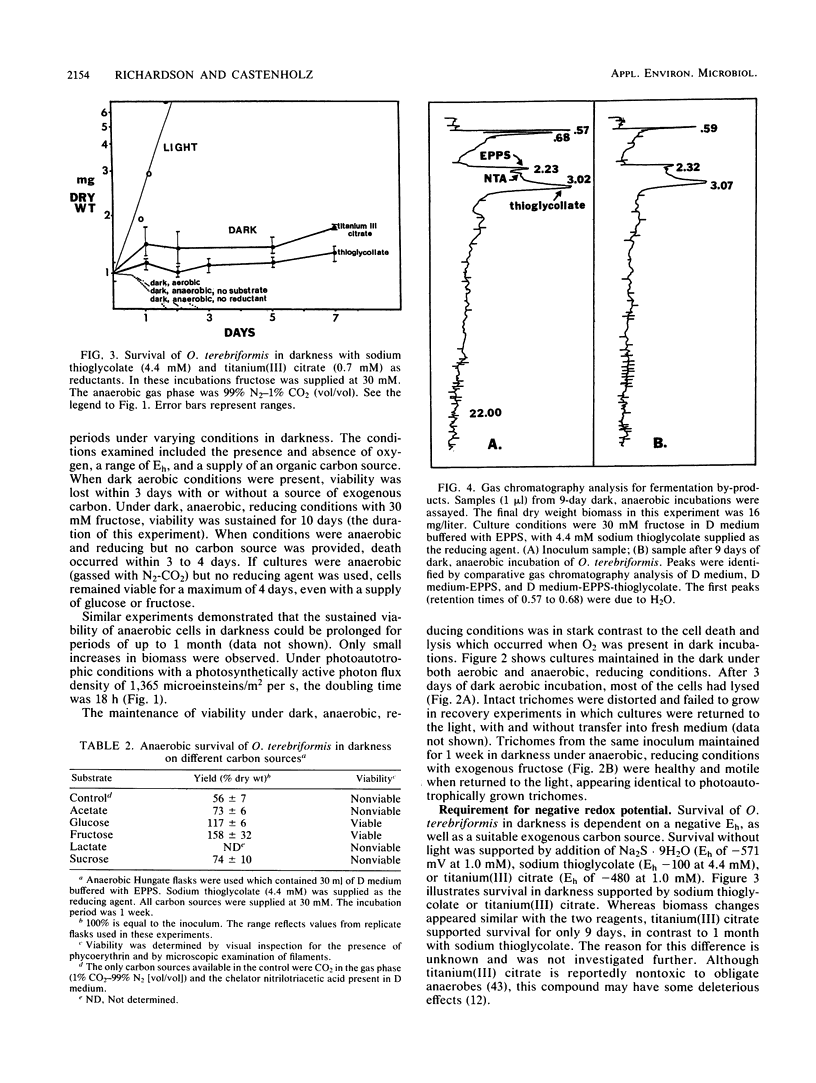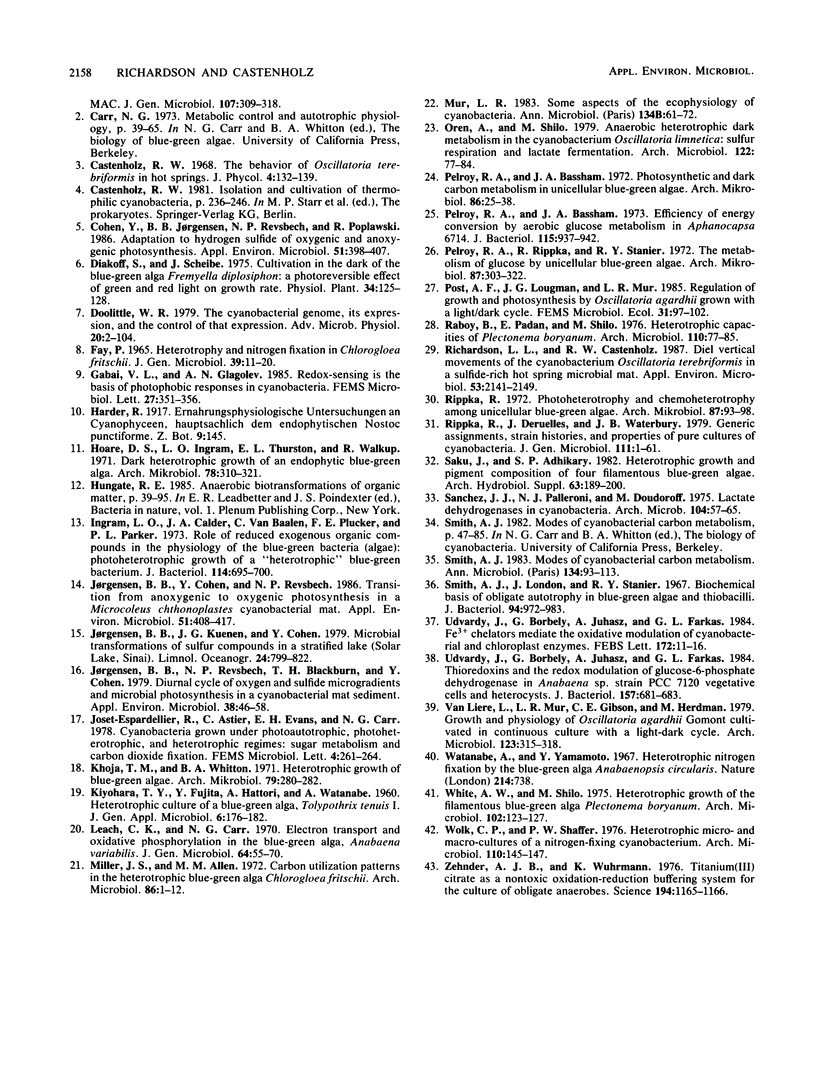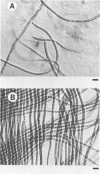Abstract
Oscillatoria terebriformis, a thermophilic cyanobacterium, maintained viability in darkness under anaerobic conditions by fermenting exogenous glucose or fructose to lactic acid. The time period of survival was greatly extended when the environmental redox potential was lowered by the addition of sodium thioglycolate or titanium(III) citrate. When exposed to aerobic conditions in darkness, many trichomes underwent lysis in 6 h, and death of all cells occurred in 2 to 3 days. The endogenous aerobic respiration rate was high, and the limited dark aerobic survival period appeared to be due to depletion of stored glycogen. Fructose or glucose did not support or increase aerobic respiration in darkness or lengthen aerobic survival time. Enhanced survival of O. terebriformis in darkness under anaerobic, reducing conditions correlates well with the natural nighttime position of this species within sulfide-rich microbial mats associated with hot springs of western North America.
Full text
PDF







Images in this article
Selected References
These references are in PubMed. This may not be the complete list of references from this article.
- Cohen Y., Jørgensen B. B., Revsbech N. P., Poplawski R. Adaptation to Hydrogen Sulfide of Oxygenic and Anoxygenic Photosynthesis among Cyanobacteria. Appl Environ Microbiol. 1986 Feb;51(2):398–407. doi: 10.1128/aem.51.2.398-407.1986. [DOI] [PMC free article] [PubMed] [Google Scholar]
- FAY P. HETEROTROPHY AND NITROGEN FIXATION IN CHLOROGLOEA FRITSCHII. J Gen Microbiol. 1965 Apr;39:11–20. doi: 10.1099/00221287-39-1-11. [DOI] [PubMed] [Google Scholar]
- Ingram L. O., Calder J. A., Van Baalen C., Plucker F. E., Parker P. L. Role of reduced exogenous organic compounds in the physiology of the blue-green bacteria (algae): photoheterotrophic growth of a "heterotrophic" blue-green bacterium. J Bacteriol. 1973 May;114(2):695–700. doi: 10.1128/jb.114.2.695-700.1973. [DOI] [PMC free article] [PubMed] [Google Scholar]
- Jørgensen B. B., Cohen Y., Revsbech N. P. Transition from Anoxygenic to Oxygenic Photosynthesis in a Microcoleus chthonoplastes Cyanobacterial Mat. Appl Environ Microbiol. 1986 Feb;51(2):408–417. doi: 10.1128/aem.51.2.408-417.1986. [DOI] [PMC free article] [PubMed] [Google Scholar]
- Jørgensen B. B., Revsbech N. P., Blackburn T. H., Cohen Y. Diurnal cycle of oxygen and sulfide microgradients and microbial photosynthesis in a cyanobacterial mat sediment. Appl Environ Microbiol. 1979 Jul;38(1):46–58. doi: 10.1128/aem.38.1.46-58.1979. [DOI] [PMC free article] [PubMed] [Google Scholar]
- Leach C. K., Carr N. G. Electron transport and oxidative phosphorylation in the blue-green alga Anabaena variabilis. J Gen Microbiol. 1970 Nov;64(1):55–70. doi: 10.1099/00221287-64-1-55. [DOI] [PubMed] [Google Scholar]
- Miller J. S., Allen M. M. Carbon utilization patterns in the heterotrophic blue-green alga Chlorogloea fritschii. Arch Mikrobiol. 1972;86(1):1–12. doi: 10.1007/BF00412395. [DOI] [PubMed] [Google Scholar]
- Mur L. R. Some aspects of the ecophysiology of cyanobacteria. Ann Microbiol (Paris) 1983 Jul-Aug;134B(1):61–72. doi: 10.1016/s0769-2609(83)80097-0. [DOI] [PubMed] [Google Scholar]
- Pelroy R. A., Bassham J. A. Efficiency of energy conversion by aerobic glucose metabolism in Aphancapsa 6714. J Bacteriol. 1973 Sep;115(3):937–942. doi: 10.1128/jb.115.3.937-942.1973. [DOI] [PMC free article] [PubMed] [Google Scholar]
- Pelroy R. A., Bassham J. A. Photosynthetic and dark carbon metabolism in unicellular blue-green algae. Arch Mikrobiol. 1972;86(1):25–38. doi: 10.1007/BF00412397. [DOI] [PubMed] [Google Scholar]
- Pelroy R. A., Rippka R., Stanier R. Y. Metabolism of glucose by unicellular blue-green algae. Arch Mikrobiol. 1972;87(4):303–322. doi: 10.1007/BF00409131. [DOI] [PubMed] [Google Scholar]
- Raboy B., Padan E., Shilo M. Heterotrophic capacities of Plectonema boryanum. Arch Microbiol. 1976 Oct 11;110(1):77–85. doi: 10.1007/BF00416971. [DOI] [PubMed] [Google Scholar]
- Rao K. S., Tulpule P. G. Varietal differences of groundnut in the production of aflatoxin. Nature. 1967 May 13;214(5089):738–739. doi: 10.1038/214738b0. [DOI] [PubMed] [Google Scholar]
- Sanchez J. J., Palleroni N. J., Doudoroff M. Lactate dehydrogenases in cyanobacteria. Arch Microbiol. 1975 Jun 20;104(1):57–65. doi: 10.1007/BF00447300. [DOI] [PubMed] [Google Scholar]
- Smith A. J., London J., Stanier R. Y. Biochemical basis of obligate autotrophy in blue-green algae and thiobacilli. J Bacteriol. 1967 Oct;94(4):972–983. doi: 10.1128/jb.94.4.972-983.1967. [DOI] [PMC free article] [PubMed] [Google Scholar]
- Smith A. J. Modes of cyanobacterial carbon metabolism. Ann Microbiol (Paris) 1983 Jul-Aug;134B(1):93–113. doi: 10.1016/s0769-2609(83)80099-4. [DOI] [PubMed] [Google Scholar]
- Udvardy J., Borbely G., Juhåsz A., Farkas G. L. Thioredoxins and the redox modulation of glucose-6-phosphate dehydrogenase in Anabaena sp. strain PCC 7120 vegetative cells and heterocysts. J Bacteriol. 1984 Feb;157(2):681–683. doi: 10.1128/jb.157.2.681-683.1984. [DOI] [PMC free article] [PubMed] [Google Scholar]
- White A. W., Shilo M. Heterotrophic growth of the filamentous blue-green alga Plectonema boryanum. Arch Microbiol. 1975;102(2):123–127. doi: 10.1007/BF00428356. [DOI] [PubMed] [Google Scholar]
- Wolk C. P., Shaffer P. W. Heterotrophic micro- and macrocultures of a nitrogen-fixing cyanobacterium. Arch Microbiol. 1976 Nov 2;110(23):145–147. doi: 10.1007/BF00690221. [DOI] [PubMed] [Google Scholar]
- Zehnder A. J., Wuhrmann K. Titanium (III) citrate as a nontoxic oxidation-reduction buffering system for the culture of obligate anaerobes. Science. 1976 Dec 10;194(4270):1165–1166. doi: 10.1126/science.793008. [DOI] [PubMed] [Google Scholar]




